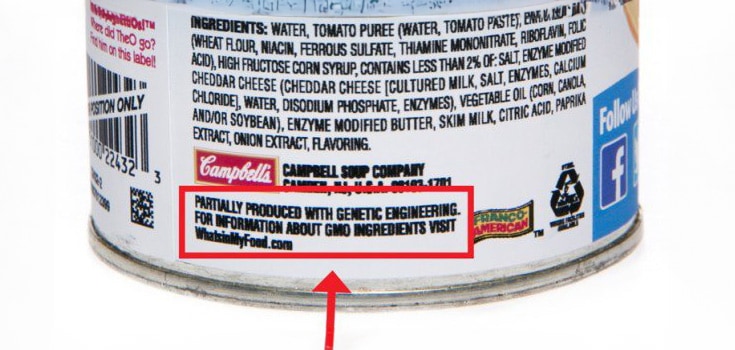At Long Last, Mandatory GMO Labels Are Coming to Food Packaging

Food companies will soon be required to disclose when their products contain genetically modified (GM) ingredients, but you might be disappointed by their vagueness and some of the loopholes that go with the U.S. Department of Agriculture’s proposed ‘food transparency’ rule.
For example, companies won’t necessarily be required to list refined GM sugars and oils, particularly if the GM ingredients fall below a predetermined threshold, according to a proposed rule released by the Agriculture Department on May 3, 2018. [1]
Under the proposed rule, food makers must use the term “bioengineered” instead of the more commonly known “genetically modified.”
The proposed rule will now undergo a public comment period, giving people the opportunity to weigh in on both the wording of the labels and how they ought to be applied, and could be finalized as early as this summer. Whether or not foods produced using CRISPR gene-editing technology should be required to carry a GMO label is one of the topics the USDA is seeking comment on. [1] [2]
Health-conscious buyers have been clamoring for the labels for years, and in 2016 Congress passed a mandatory-labeling law that was delayed by questions about which foods should garner a label and what types of labels food companies should use. [1]
Unsurprisingly, food and consumer groups are happy that the labels are finally becoming a reality. However, there is concern about the types of products that could be excluded from the rule and the possible buyer confusion that will certainly come with it.
Colin O’Neil, the legislative director for the Environmental Working Group (EWG), said:
“We think, at the most fundamental level, consumers expect the mandatory GM labeling standard to apply to all GM foods.”
To Tell the Truth…Sort of
According to the U.S. Department of Agriculture (USDA), food companies can choose from 3 different options for disclosing ingredients:
- A 1-sentence declaration saying something along the lines of, “contains a bioengineered food ingredient.”
- A standardized icon, such as the one used by the National Organic Program.
- A QR code or other digital marker that directs shoppers to a website for more information.



The Grocery Manufacturers Association said it is pleased with the flexible standards, noting that it has already affixed QR codes on 25,000 products through its SmartLabel program.
“We welcome the release of the proposed rule … and will be working with our member companies to review and develop comments on the draft rule and the USDA questions.
Our comments to USDA will reflect the ongoing commitment of our member companies to providing consumers with the transparency they need to make informed product choices.”
The question is, do QR codes really qualify as “clear labeling” of GMOs? As EcoWatch points out, QR codes require a smartphone and a reliable broadband connection – something that’s not always readily available in rural areas. In fact, QR codes could potentially leave 100 million Americans who lack the necessary technology to read the codes in the dark about what they’re eating. [2]
Andrew Kimbrell, executive director at Center for Food Safety (CFS), stated matter-of-factly that the “USDA should not allow QR codes.” He added:
“USDA’s own study found that QR codes are inherently discriminatory against 1/3 of Americans who do not own smartphones, and even more so against rural, low-income, and elderly populations or those without access to the Internet. USDA should mandate on-package text or symbol labeling as the only fair and effective means of disclosure for GE foods.”
What Constitutes “GMO?”
The USDA has also proposed several options as to which foods will be considered “genetically modified.” One plan exempts highly refined sugars and oils, such as those made from GM corn, soybeans, and sugar beets – all 3 foods are among the most genetically modified crops in the U.S.
The department said this is based on the grounds that the refinement process screens out modified DNA. But consumer groups argue that this would effectively exempt up to 70% of covered food products from GMO labeling.
Genetically modified canola, corn, soybeans, and sugar beets themselves will be required to carry the GMO label. [3]

Another plan would allow the USDA to exempt products containing ingredients from mixed sources that are less than 5% genetically modified by weight. That sounds like a small percentage, but it’s high in comparison to China, Russia, and the European Union (EU), as well as the where the threshold is a mere 0.9%. That is also the threshold adhered to by the voluntary initiative Non-GMO Project. [1]
The potential exemptions, and the USDA’s decision to use the term “bioengineered,” has advocacy groups up in arms, and rightfully so.
Wenonah Hauter, the executive director of the consumer group Food & Water Watch, said:
“The USDA’s proposed loophole-ridden GMO labeling rules are a giveaway to the agribusiness and food industries that want to keep consumers in the dark about what they are eating.”
The public has until July 3, 2018 to comment on the proposed rules, which are set to be finalized on July 29. However, the rules are not likely to be finalized before summer’s end, according to Agriculture Secretary Sonny Perdue.
Sources:
[2] EcoWatch
[3] Bloomberg News
